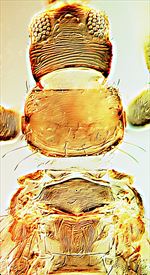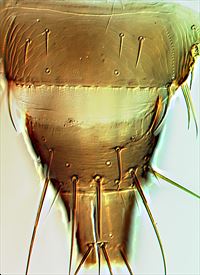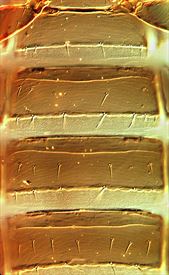Distinguishing features
Female fully winged. Body and legs light brown, abdominal segments IX–X dark brown; antennal segments light brown to brown, III scarcely paler; fore wing weakly shaded. Antennae 7-segmented; VII short, III and IV each with a forked sense cone. Head wider than long, with transverse sculpture lines, ocellar setae pair III just anterior to ocellar triangle. Pronotum with weak transverse lines; 2 or 3 pairs of posteromarginal setae, posteroangular setae long and slender. Metanotum irregularly reticulate postero-medially, campaniform sensilla present. Fore wing with complete setal rows on both veins. Tergites laterally with a posteromarginal fringe of microtrichia, transverse sculpture lines present between median setal pair; paired ctenidia present on V–VIII; posteromarginal comb on VIII irregular, microtrichia sometime arising in groups, median microtrichia weak. Pleurotergites usually with 2 discal setae. Sternite II with 3 pairs of marginal setae, III–VII with about 4–8 discal setae.
Male not known.
Related species
There are 13 species of the genus Thrips recorded from New Zealand, of which five comprise an endemic group, out of a total of 280 species worldwide (Mound & Masumoto, 2005). All members of Thrips genus have paired ctenidia on the tergites, and on tergite VIII these are postero-mesad to the spiracles; these species also lack ocellar setae pair I in front of the first ocellus. In contrast, Frankliniella species have ctenidia on tergite VIII antero-lateral to the spiracles, and a pair of setae is always present in front of the first ocellus.Thrips martini is one of the five New Zealand endemic species in the genus Thrips. These five all share the presence of three pairs of posteromarginal setae on sternite II, in contrast to the two pairs found in the other 275 species of this genus from other parts of the world. These New Zealand species also all have two complete rows of setae on the fore wing, and have discal setae on the sternites and pleurotergites. Thrips martini is particularly similar to Thrips austellus, but has the abdominal apex dark brown, the sternites and pleurotergites with fewer discal setae, and the pronotal setae much longer.
Biological data
The only recorded host plant is Hebe brachysiphon [Plantaginaceae]
Distribution data
A New Zealand endemic recorded only from South Island (NC).
Family name
THRIPIDAE, THRIPINAE
Species name
Thrips martini Mound & Masumoto
Original name and synonyms
Thrips martini Mound & Masumoto, 2005: 36
References
Mound LA & Masumoto M (2005) The genus Thrips (Thysanoptera, Thripidae) in Australia, New Caledonia and New Zealand. Zootaxa 1020: 1–64.



